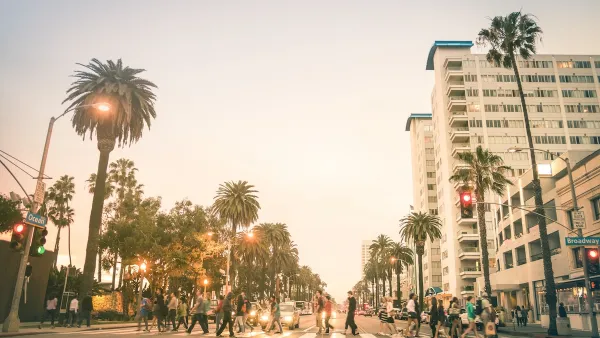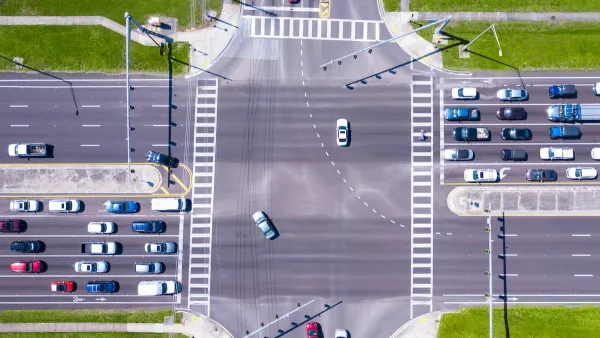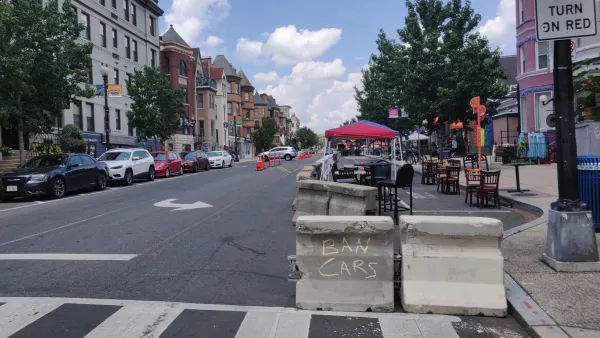Dangerous by Design 2021 quantifies the transportation sector's ongoing neglect of the health and safety of people performing that basic human action of taking a walk.

Smart Growth America today published Dangerous by Design 2021, the latest edition of an annual report that quantifies the number of pedestrians struck and killed by automobile drivers in the previous year. 2020, despite lower vehicles miles traveled and people of all ages staying indoors for most of the year, was tragic at the same scale as 2019—and a huge increase over the totals from a mere decade ago.
An article by Steve Davis presents key insights into this year's report, estimating the number of pedestrians killed at 6,237, a slight decrease from 2019's total of 6,283. Viewed on a longer timeline, the fatalities are even more devastating.
"Over the past decade (2010-2019), the number of people struck and killed by drivers nationwide while walking increased by an astonishing 45 percent," writes Davis. "The four most recent years on record (2016-2019) are now the four most deadly years for pedestrian deaths since 1990. During this ten-year period, 53,435 people were hit and killed by drivers. In 2019, the 6,237 people struck and killed is the equivalent of more than 17 people killed per day." [Emphasis from the original.]
According to the report, the risk to pedestrians is not evenly distributed: "Black Americans, older adults, people walking in low-income communities, and American Indian or Alaska Native people all die at higher rates and face higher levels of risk compared to all Americans."
The report also includes a "Pedestrian Danger Index" that further illustrates that disparate impact. The Orlando-Kissimmee-Sanford metropolitan statistical area tops the list, followed by Bakersfield, California and Memphis Tennessee.
The article includes a few examples of dangerous street designs, from Philadelphia and Gainesville to illustrate the need to change the practices of street design that continue to prioritize vehicles speed over pedestrian safety.
"We continue to design and operate streets that prioritize the speedy movement of vehicles at the expense of safety for all people who use them. There are core tenets of roadway design that are widely accepted but that actively put people at risk and increase the likelihood that people will continue to pay the price. These street design practices can also set drivers up to fail by making it easier to make mistakes with deadly consequences, even when following the rule," according to the article.
FULL STORY: 45 percent increase in people struck and killed while walking because streets are Dangerous by Design

Analysis: Cybertruck Fatality Rate Far Exceeds That of Ford Pinto
The Tesla Cybertruck was recalled seven times last year.

National Parks Layoffs Will Cause Communities to Lose Billions
Thousands of essential park workers were laid off this week, just before the busy spring break season.

Retro-silient?: America’s First “Eco-burb,” The Woodlands Turns 50
A master-planned community north of Houston offers lessons on green infrastructure and resilient design, but falls short of its founder’s lofty affordability and walkability goals.

Test News Post 1
This is a summary

Analysis: Cybertruck Fatality Rate Far Exceeds That of Ford Pinto
The Tesla Cybertruck was recalled seven times last year.

Test News Headline 46
Test for the image on the front page.
Urban Design for Planners 1: Software Tools
This six-course series explores essential urban design concepts using open source software and equips planners with the tools they need to participate fully in the urban design process.
Planning for Universal Design
Learn the tools for implementing Universal Design in planning regulations.
EMC Planning Group, Inc.
Planetizen
Planetizen
Mpact (formerly Rail~Volution)
Great Falls Development Authority, Inc.
HUDs Office of Policy Development and Research
NYU Wagner Graduate School of Public Service




























